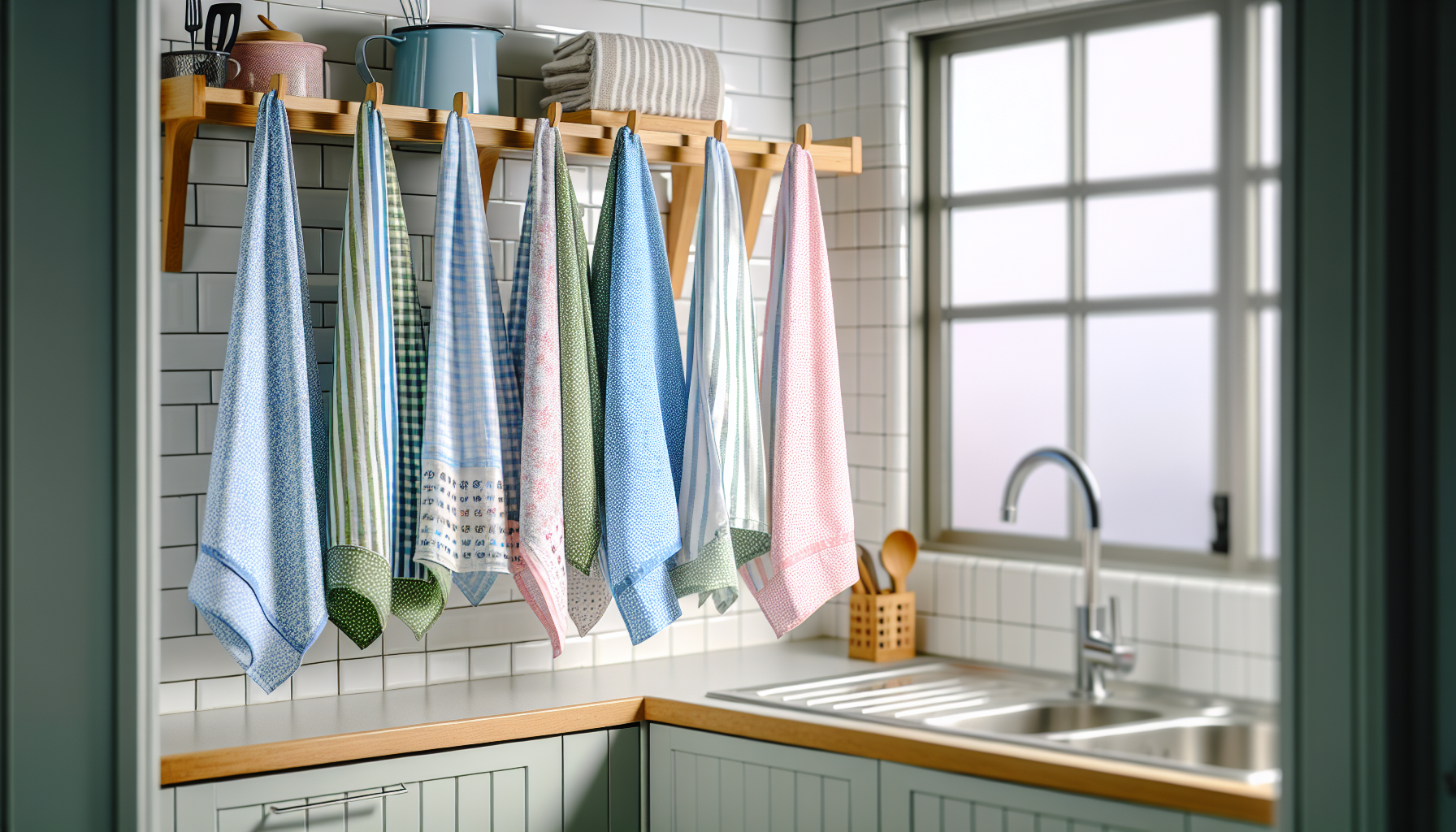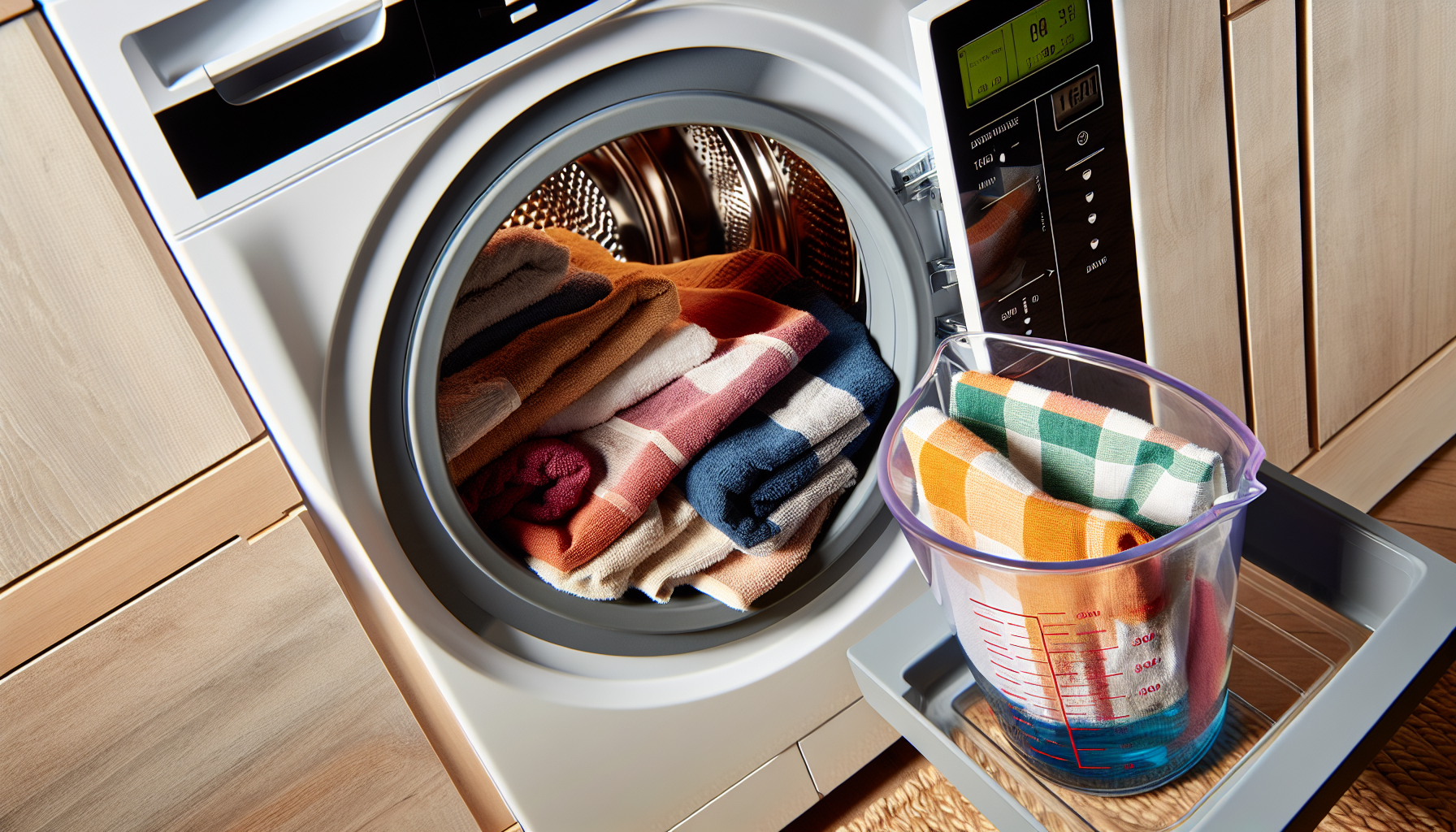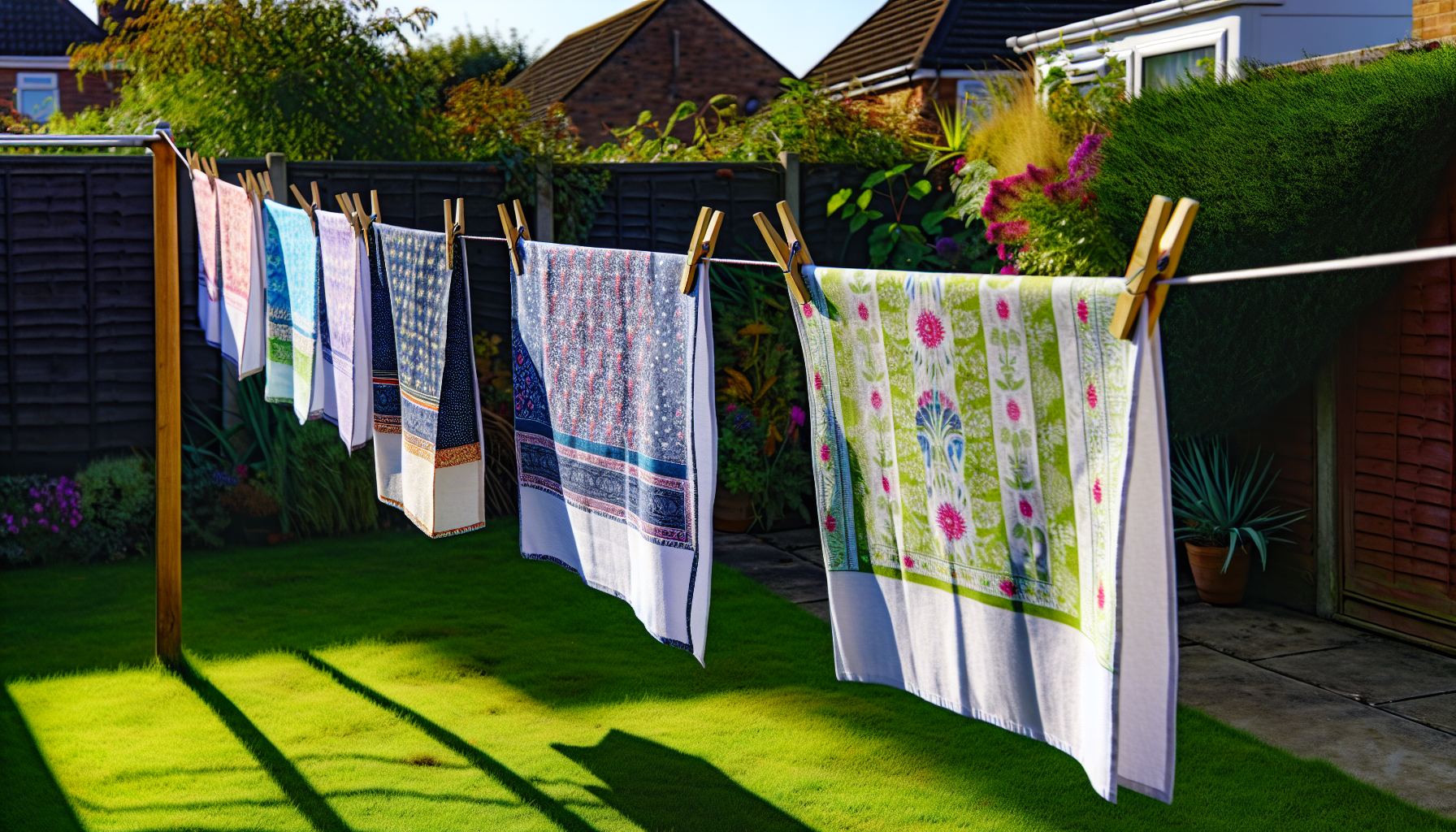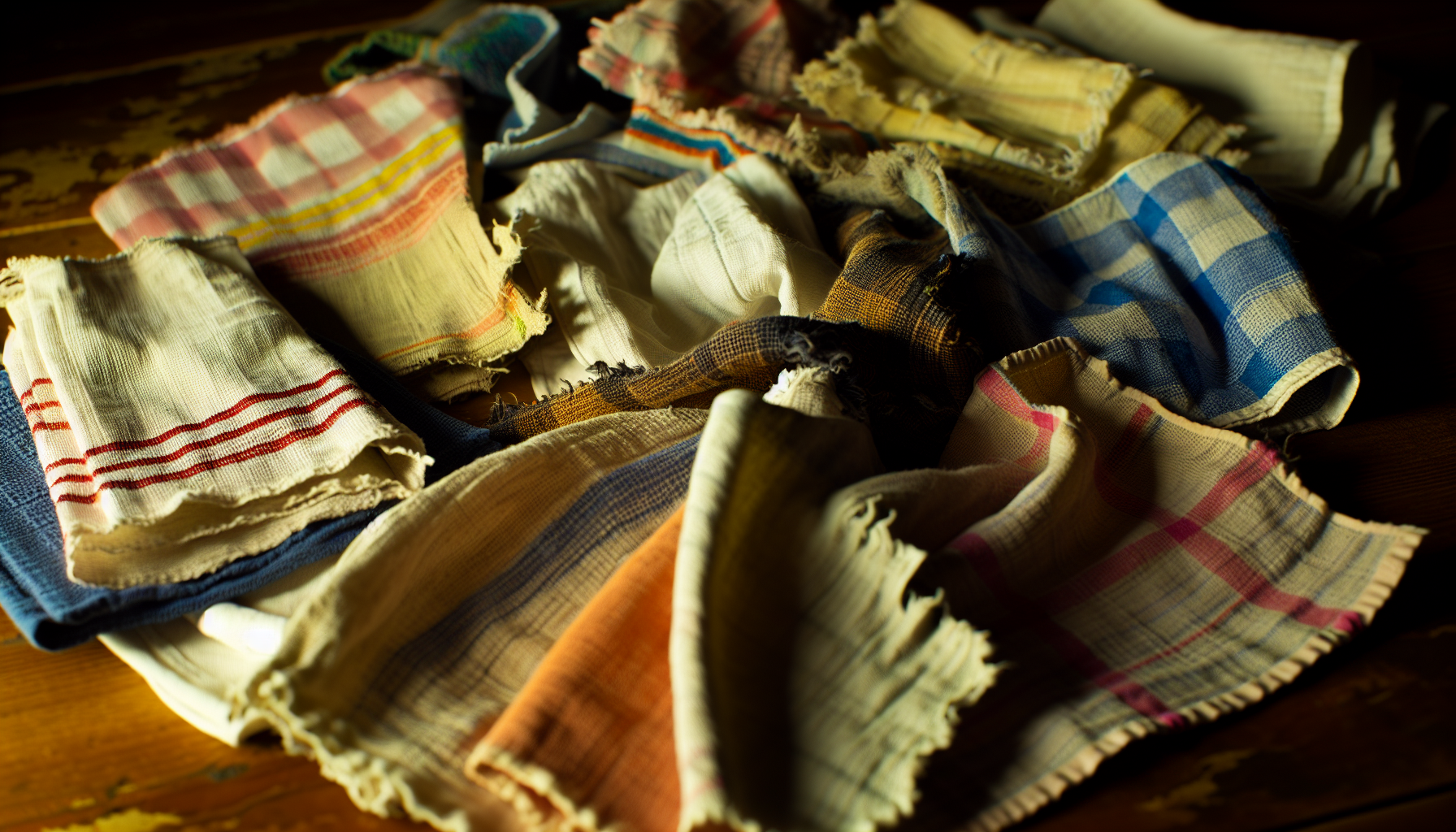Continental U.S. only.
Continental U.S. only.
Are tea towels causing you a headache? Washing them is simpler than you think. Ditch the bacteria and stains with our easy guide on how to wash tea towels. We cover the no-nonsense essentials—from picking the right wash cycle to effective natural solutions—ensuring you achieve spotless results without hassle. Here’s your straightforward path to hygienic kitchen towels.
✔ Wash your tea towels regularly—at least once a day for busy kitchens or up to weekly for light use—to prevent bacteria build-up and maintain kitchen hygiene.
✔ Use a hot cycle (60°C or higher) in the washing machine with a biological detergent and, if you prefer, an antibacterial additive or bleach alternative like OxiClean to sanitize tea towels effectively.
✔ For hand washing tea towels, remove debris and stains with natural solutions like vinegar or baking soda before soaking, and ensure they’re thoroughly dried and stored properly to avoid mildew.

Tea towels, the hardworking essentials of our kitchen, can easily become troublesome if not properly maintained. They constantly come into contact with our hands, food spills and various surfaces. Creating an ideal breeding ground for germs. The warm and damp conditions found in kitchens are particularly conducive to bacterial growth. Bacteria such as Staphylococcus aureus, Enterobacter and E.coli thrive on the combination of moisture and leftover food particles.
Don’t worry! There is a simple solution, regularly wash your tea towels and replace them when necessary. This will help reduce the presence of bacteria in your kitchen environment ensuring it remains clean and hygienic at all times. Think of it as a small but significant step towards maintaining a healthier living space.
Frequent washing of your tea towels is not just important for a clean kitchen, but also for maintaining good health. Think about it - your dish cloths come in contact with various surfaces and objects, making them vulnerable to bacteria transfer. Using the same towel for drying hands, dishes and cleaning up spills increases the risk of bacterial buildup.
Preventing this spread of bacteria and potential foodborne illnesses can be as simple as regularly switching out and laundering your dish cloths and tea towels. This small effort can have a significant impact on your overall well-being.
Unsure about how often to change out those dish towels? If your kitchen is the center of activity where meals are made daily, it’s recommended to wash tea towels every day for maximum cleanliness. If your kitchen sees less action and is mostly used for making coffee or heating up quick meals, you can get by with washing them every 3-7 days.
Regardless of usage frequency, remember one important rule: significantly dirty tea towels should be washed at least once a week. Trust us, both your kitchen and your health will appreciate it.

After learning about the recommended washing frequency for tea towels, it’s important to understand the specific steps involved in machine washing them. For those who prefer using a washing machine, there are certain key factors to keep in mind. The most crucial one being that hot water should be used during the wash cycle for hygienic cleanliness.
You may worry that hot water could shrink your fabrics, but this is not a concern when it comes to tea towels! In fact, using hot water is highly effective in achieving thorough sanitization of these kitchen essentials. Simply increasing the temperature isn’t enough. Proper choice of detergent and understanding different cycles also play an important role. While some swear by adding bleach as part of their laundry routine, others question its effectiveness on tea towel sanitation, making it a contentious subject among households.
Selecting the appropriate detergent for your tea towels is similar to choosing the right tool for a specific task. For effective removing stains, opt for a biological detergent as it contains enzymes that are highly efficient in breaking down different types of stains commonly found on kitchen towels.
Concerned about bacteria? No need to worry, an antibacterial laundry additive can come to your rescue! Including this product in your washing cycle helps eliminate various forms of bacteria, improving the hygiene and cleanliness of your tea towels significantly.
Hot water is not just useful for making your tea or coffee, it also plays a crucial role in keeping your tea towels clean and free of bacteria. By using hot water at 60°C to wash them, you can effectively kill any harmful bacteria that may be present on the towels from their use in food preparation.
For even greater sanitation, following the recommendation by UK government guidelines, washing tea towels at a higher temperature of 90°C will thoroughly eliminate any potential bacterial contamination. It is advised to consistently opt for a hot wash cycle when laundering these essential kitchen items as part of regular hygiene maintenance.
Tea towels are often thought of as the go-to cleaning tool, but they may not always need to rely on bleach for stain removal. While using traditional bleach can be effective in getting rid of stains, it can also weaken the fabric and decrease the lifespan of cotton tea towels over time. Fortunately, there is a better alternative, OxiClean.
Creating a soaking solution with hot water and just one capful of an oxygen-based cleaner like OxiClean has proven to effectively remove tough stains without causing any harm or damage to your tea towel fibers. And if you want to maintain their vibrant colors during washing, simply add a color catcher sheet which will protect against color bleeding between different fabrics in order to preserve the original hues of your precious tea towels.

If you prefer not to machine wash your tea towels or want to show them a bit of extra care, hand washing is a great option. Not only can it be therapeutic, but also effective in getting rid of dirt and stains. Here are some simple steps for hand washing tea towels like a pro.
Firstly, remove any solid debris from the towel and rinse it under cold water to dilute tough stains. Next, prepare for hand washing by filling up a basin with hot water and adding just enough gentle detergent – if dealing with delicate fabrics, opt for cooler water instead to avoid damage. Submerge the tea towel into the soapy basin and gently agitate it by hand to loosen any remaining dirt particles. Thoroughly rinse off all soap suds before wringing out excess water carefully (to prevent fabric damage). And there you have it! Your clean tea towel is now ready for drying.
To properly wash your tea towels, here is a step-by-step guide.
Begin by filling a basin with lukewarm water.
Add some liquid dish soap to the water for an effective and gentle clean.
Let the tea towel soak in this soapy solution for about 30 minutes, especially if there are tough stains that need lifting.
After soaking, gently move the towel around in the water as though going through a rinse cycle to ensure thorough cleaning.
Next comes hand washing, use your hands to rub and scrub any heavily soiled areas on the tea towel using either a soft brush or cloth. Then carefully squeeze out excess moisture from each towel without twisting or wringing them, before rinsing thoroughly with cold water to remove any remaining soap residue and cool down the fabric during its final phase of cleansing procedure- allowing you now enjoy beautifully-washed, cleaner-looking dishes!
Did you know that there are natural alternatives to harsh chemicals for removing stains from tea towels? Instead of using traditional stain removers, we can turn to nature for powerful options such as vinegar, baking soda, salt and lemon juice. Using fabric softener is a gentle yet effective way to remove stains without causing damage to the fabric itself.
For tough or oily stains on tea towels, mixing water with white vinegar makes an excellent pre-treatment solution. Similarly, combining baking soda with dish soap creates a paste that can effectively tackle stubborn grease marks. If you prefer gentler methods of stain removal, try creating a pasty mixture of baking soda and water which works as an abrasive tool while being kinder on fabrics. To get rid of any residue left behind by detergents (which could actually make existing stains worse), it’s recommended to wash your tea towels with both vinegar and baking soda.
In summary, when dealing specifically with pesky towel spills or spots, check if these natural solutions might work first! Resorting immediately into buying more cleansers may even be less costly either.
Stubborn stains can be a challenge, even with our best efforts. But don’t lose hope! There are advanced techniques to help you win the battle against tough tea towel stains.
To tackle color-rich marks on your towels, mix hot water and oxygen-based bleach in a paste and apply it directly onto the stain as a pre-treatment. An enzyme-based solution is also effective for breaking down red wine spills on tea towels.
For older or set-in stains, spot treat them with remover before washing your towel with biological detergent. Alternatively, try soaking the affected area in stain remover solution prior to regular washes.
Before placing your tea towels in the washing machine, make sure to check for any visible stains. These should be treated with a targeted stain remover before cleaning. If you need immediate treatment, apply a spot remover and use a lint-free cloth to soak up excess water before air drying the towel.
For tough stains like wine or coffee that are rich in color, mix together hot water and an oxygen-based bleach specifically made for colors after applying stain removal solution. You can also opt for hydrogen peroxide instead of chlorine bleach as it is safer but just as effective at whitening and disinfecting during pre-treatment of tea towels.
Lastly, using biological detergent while washing tea towels can assist in removing stubborn stains when used alongside pre-treatment methods.
When trying to keep tea towels clean and free of stains, it’s crucial to be aware of what methods should not be used. One such method is using paper towels when removing stains. This can actually worsen the situation by leaving behind lint that makes stain removal more challenging.
Instead, opt for alternative tools like a cloth specifically designed for cleaning without producing lint or even your own finger as a gentle scrubber with the stain solution. Using a white cloth is also advised in order to avoid any transfer of color while treating stubborn marks on fabric.

After thoroughly cleaning your tea towels, it’s important to properly dry and store them in order to maintain their quality. To achieve this, you can either air dry them or use a tumble dryer on low heat with wool dryer balls for faster drying.
But what about wrinkles? You can easily remove them by ironing the tea towels on the reverse side while they are still slightly damp. As for storage, hanging your tea towels on hooks or towel bars is best as it allows proper air circulation and helps prevent mustiness or mildew from developing.
Drying your tea towels in the open air is not only a way to save energy, but also essential for maintaining hygiene. The presence of moisture can create an ideal environment for bacteria to thrive on kitchen towels, so ensuring they are completely dried is crucial. To speed up the drying process, you can place a dry towel underneath and gently press down after rolling them together.
Opting to sun-dry your tea towels has additional benefits such as enhancing their bleaching effect if previously treated with lemon juice. It’s important to hang them with the pattern facing away from direct sunlight in order to prevent any fading of colors or patterns over time.
When it comes to storing tea towels, simply stuffing them into a random drawer won’t cut it. It’s important to ensure they are both easily accessible for regular use and kept in a way that minimizes the risk of mold growth or contamination. A great place to store your tea towels is on an open shelf or towel rack, away from any damp items.
To keep things organized, try rolling up your tea towels neatly before placing them in drawers with shallow baskets or containers, this will help you save space while maintaining tidiness. Another useful tip is implementing color-coding. Assign specific tasks for each colored towel to avoid cross-contamination when using different types of cloths. Lastly, consider storing seasonal tea towels together with other decorations related specifically to those seasons as another efficient way of saving room.
In order not to lose track of all these organizational strategies mentioned above, make sure to always have easy access to your bath towels and new ones by keeping some distance between wet items and them.Following these tips can help you maintain a healthy life.

Like any other item, tea towels have a limited lifespan and it is important to know when to replace them just as much as knowing how to properly clean and store them. It is crucial for maintaining hygiene in the kitchen that regular checks are done on the condition of these towels.
If despite multiple OxiClean treatments, persistent odors cannot be completely removed from tea towels, then it’s time for new ones. Another sign indicating replacement would be if they no longer absorb water efficiently and remain constantly damp after use. Any visible signs of deterioration like ripping or fraying should not be ignored either. Nor should a rough texture developing over time necessitate getting rid of old tea towels. Usually lasting about one or two years depending on frequency of usage and quality, replacing kitchen wipes becomes necessary at some point.
When dealing with laundry, it can be risky to mix items. To avoid cross-contamination, tea towels should always be washed separately from other laundry. But what if your load has a mix of colors? Not to worry, using a Color Catcher when washing colored items will protect against color bleeding.
So remember these tips the next time you’re sorting your dirty clothes: keep tea towels separate, use a Color Catcher for colored loads, and make sure your machine is set to hot wash cycle. By following these steps, you’ll ensure that your tea towels are thoroughly cleaned without any bacteria lingering behind for fresh and clean results!
Here is a complete guide for keeping your tea towels clean, dry and stored properly. It’s important to regularly wash them to maintain their freshness. Learn how to effectively machine or hand wash them and remove stubborn stains, as well as discover storage tips. And don’t forget when it’s time to replace these essential kitchen companions – always make sure they are clean for a happy and healthy cooking experience! So let’s get started by learning the secrets of sparkling tea towels.
For optimal durability and absorbency, it is recommended to either hang tea towels for air drying or use a low heat setting in the dryer. To preserve their quality, consider ironing them on the opposite side while slightly damp.
It’s important to limit frequent use of the tumble dryer as this can weaken the fabric over time. Instead, opt for alternative methods such as hanging or low-heat drying when possible.
The Food Standards Agency advises that it is best to wash tea towels separately from other laundry in order to avoid cross-contamination. This means specifically washing your tea towels on their own, instead of mixing them with other clothing items during a regular load of laundry.
According to the Food Standards Agency, it is recommended that tea towels be washed every 3-7 days. If they are not being used frequently, washing them once a week would suffice. Keeping this hygiene routine for your tea towels will ensure cleanliness and sanitation.
For effective cleaning of dishcloths, you can soak them in a mixture of warm water and vinegar for about 15 minutes. Then, add baking soda to eliminate any lingering odors. If your cloths are white, use bleach when washing. Whereas if they are colored, opt for Clorox 2 along with your regular detergent. Make sure to wash on a hot cycle and allow the cloths to dry completely before using again.
For optimal results, it is recommended to wash tea towels separately from any other laundry in order to avoid mixing and potential cross-contamination. This becomes especially important when washing with colored items. Consider using a Color Catcher sheet as an extra precaution against color bleeding.
Remember the importance of keeping your tea towels clean!